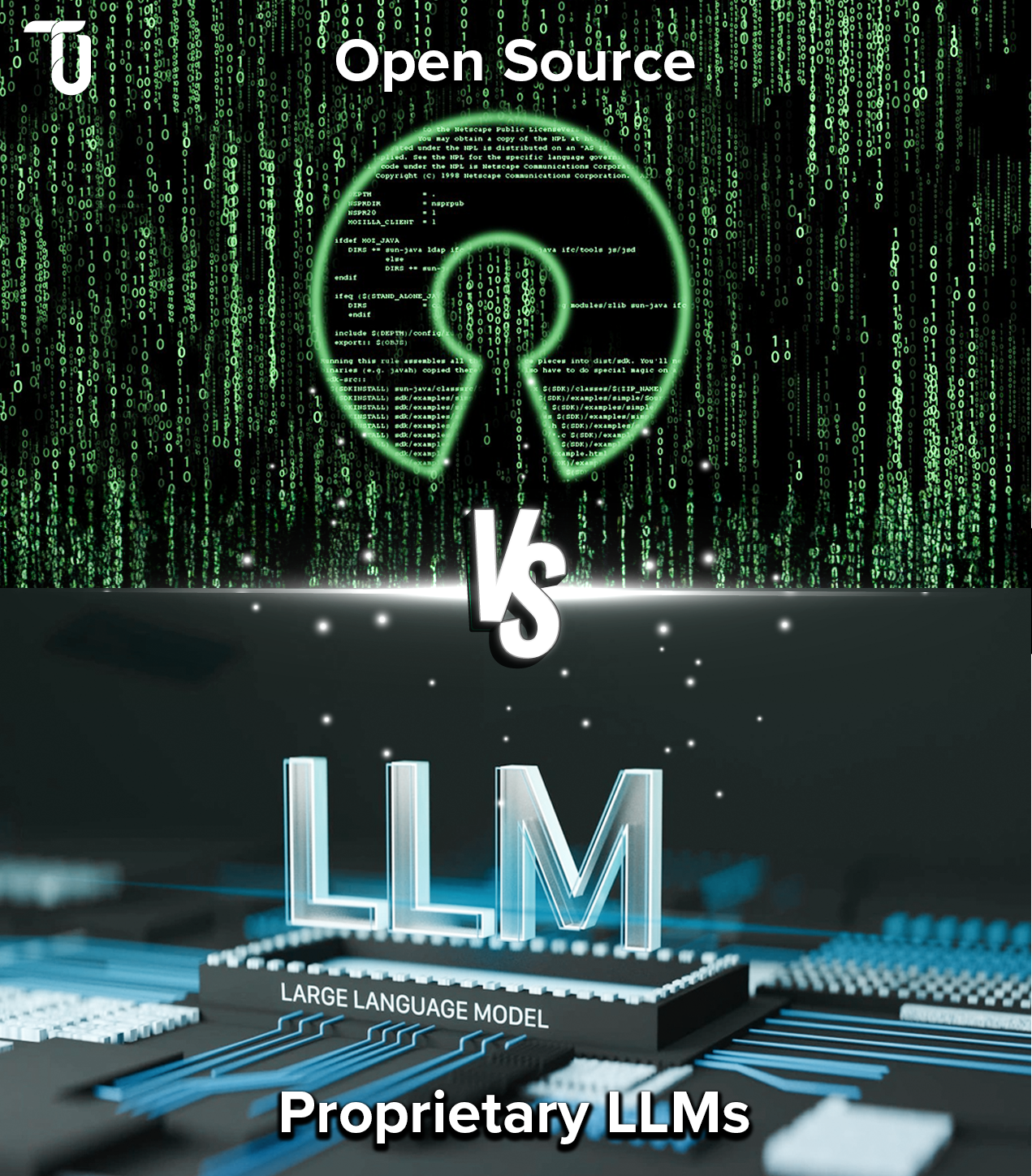What is an Open-source LLM?
An open-source LLM is a type of AI model whose code and architecture are made publicly available for anyone to use, modify, and distribute. This means you can customize the model for your specific business needs while integrating it into your AI application without restrictive licensing.
Open-source LLMs are often developed collaboratively and backed by large communities, emphasizing transparency and accessibility. They are typically shared on platforms like GitHub, where users can contribute to their development or adapt them for various applications, such as chatbots translation tools, content generation, customer support automation, etc.
While the open-source approach fosters innovation and collaboration, it also comes with challenges. For instance, the quality and performance of these models can vary, and they may require technical support for implementation. Some popular open-source LLMs include Meta’s LLaMA, Microsoft’s Phi, and DeepSeek’s V3.
What is a Proprietary LLM?
A proprietary LLM (also called closed source LLM) is a privately owned AI model designed for advanced language tasks. Large companies like Open AI, Google, Anthropic, etc., develop, own, and maintain proprietary models while restricting access to their code and architecture. This control allows them to monetize and manage deployment while keeping the underlying technology private. Notable examples of proprietary LLMs include OpenAI’s GPT-4, Google’s Gemini, and Anthropic’s Claude.
Typically offered as commercial products, proprietary LLMs are used in applications like chatbots, content generation, virtual assistants, language translation, sentiment analysis, etc. They can be accessed through APIs or integrated platforms, and often require a subscription or pay-per-use fees.
Proprietary LLMs are known for their high performance, offering the latest models with regular updates. But their lack of transparency raises concerns like bias and accountability. They offer limited customization options, which can make them less suitable for highly specific or niche applications
Need Reliable LLM-based AI Solutions?
We build custom solutions to enhance your business operations and deliver tangible results.
Factors to Consider When Choosing Between Open-source and Proprietary LLMs
Using proprietary models when creating a PoC (Proof of Concept) or an MVP (Minimum Viable Product) is a good idea because your usage is limited, accessing these models is easier, and you can achieve high AI performance quickly. However, when it comes to utilizing a language model for your business application on an ongoing basis, you need to consider several factors. Comparing open-source and proprietary models against each of the following consideration factors will help you choose the best option:
| Factor | Open-Source LLMs | Proprietary LLMs |
|---|---|---|
| Cost | Free, but may incur infrastructure costs | Subscription or pay-per-use fees |
| Customization | Full access to modify and customize | Limited, typically via APIs |
| Data Privacy & Security | Full control, but user is responsible | Managed by the provider |
| Support & Maintenance | Community support, no formal SLAs | Professional support, SLAs, updates |
| Scalability | User manages infrastructure and scaling | Managed by the provider |
| Integration | Requires more setup and integration | Easy, with APIs and SDKs |
| Performance | Varies, may require optimization | Typically high and optimized |
| Transparency | Full code access for inspection | Limited visibility into the model |
| Compliance | User ensures compliance | Provider handles compliance |
| Community | Active open-source community | Limited community resources |
Cost: You need an upfront investment in the necessary infrastructure to host and run open-source LLMs, especially if you are hosting them locally (on-premise). However, you don’t pay a license fee for them, leading to significant savings in long-term operational costs. Contrarily, you pay an ongoing license fee to use proprietary models, making them expensive in the long run but you save on the infrastructure costs.
Open-source LLMs are beneficial for companies who want to keep a check on long-term operational costs but don’t mind an upfront investment. Contrarily, the ongoing usage fee charged for proprietary models includes their infrastructure, maintenance, and support costs. And if you have a flexible budget and your usage patterns are stable and predictable, a proprietary LLM could be a better option. Also, when you are experimenting and decide to defer infrastructure investments till you are confident with the results of your innovative AI application, go for a proprietary language model.
Customization: Though proprietary models are extensively trained on large datasets and capable of performing numerous tasks, they may require fine-tuning to perform domain-specific or niche-based custom tasks. Hosting a fine-tuned proprietary model is expensive as the parent company needs to store and manage your LLM version separately. Customizing and maintaining open-source LLM is relatively easier and cheaper, making it ideal for niche tasks.
Data Privacy and Security: With open-source LLMs, you are completely responsible and in control of managing the security of your business data and ensuring end-to-end data privacy. As proprietary LLMs run on their provider company’s platform, you must share your business data with an infrastructure that is not in your control, even though they offer many managed security features. So, you could opt for an open-source model if your company deals with sensitive customer data, which you want to secure by not sharing it with third-party platforms.
Capabilities and Performance: Proprietary models have an edge over open-source models in providing state-of-the-art results, thanks to heavy investment on research to pioneer innovation by companies like Open AI, Google, etc. Having said that, the enhancements in open-source models, driven by large communities, are soon catching up for most benchmarks and AI capabilities across use cases. So, you are likely to find both proprietary and open-source models suitable for your purpose. However, it would help to experiment with a few models and match your AI performance expectations with your chosen LLM’s capabilities
Transparency: With open-source LLMs, you get complete transparency into the source code and architecture for customization and bias removal. The companies or vendors of proprietary LLMs do not often disclose the source code, architecture and methodologies applied to build these models, making them a black-box solution. This restricts customization and poses risks of inherent biases in the models. So, if you need more control over how your LLM works and you are more interested in customization, go for an open-source model.
Support: Open-source LLMs are backed by communities of developers and technical experts who share knowledge and contribute resources for updates, enhancements, and bug fixes to facilitate the development of innovative applications. On the other hand, companies offering proprietary models provide robust and comprehensive support to help developers use their LLMs in AI solutions. With open-source LLMs, you utilize in-house or outbound technical support for model management and maintenance, and for proprietary models, you avail of the support provided by their owner companies.
Integration: A tech team must set up and manage data pipelines, access controls, and governance of open-source LLMs on your chosen infrastructure. Proprietary models are ready-made solutions with simple API and platform-based integrations with your business workflows.
Scalability: Open-source LLM setup on your own infrastructure requires additional resources for scaling. As proprietary LLMs are offered as cloud-based solutions, they are easier to scale.
Licensing: The licenses offered for open-source LLMs are flexible in terms of their usage, customization, and redistribution. However, users must follow their terms, requiring attribution or sharing improvements. Proprietary LLMs often come with restrictive licensing on how they can be used, modified, and shared.
Vendor Lock-in: With open-source models, you can switch providers or modify infrastructure as required to avoid vendor lock-in and maintain operational resilience. With proprietary LLMs, your dependency on a single vendor increases as their developer companies provide continuous support and accessibility to the model.
Considering these factors before choosing between open-source and proprietary LLMs for building your AI systems helps save costs, achieve desired AI performance, and drive innovation. At times, a hybrid approach of combining open-source and proprietary LLMs can be beneficial.
Use the Right LLM for Your AI Project with TenUp
Throughout this blog, we've highlighted the key differences between open-source and proprietary LLMs, each with its own set of advantages. Open-source LLMs offer flexibility, transparency, and cost efficiency, providing greater control over customization and security. In contrast, Proprietary LLMs provide robust performance, seamless integration, and strong support—ideal for businesses seeking a reliable, out-of-the-box solution.
Choosing the right LLM for your specific business needs can be complex. If you're unsure of which option best suits your goals or lack the resources to manage the technical aspects, TenUp is here to help. Our team specializes in building tailored AI solutions that integrate seamlessly into your operations. We’ve helped businesses across various industries enhance their workflows and achieve remarkable results. Explore our case studies to see how we’ve delivered transformative AI solutions. Let us partner with you to build the perfect AI strategy and elevate your business to the next level.
Ready to Unlock the full potential of AI for your business?
Discover how our tailored AI solutions can streamline your processes and fuel growth.
Frequently asked questions
What is open-source software?
Open-source software (OSS) comes with publicly accessible code, allowing anyone to view, modify, and share it. It fosters collaboration and innovation, offering flexibility and transparency. Examples include Linux, Apache, and Mozilla Firefox.
What is the difference between open-source and proprietary LLMs?
Open-source LLMs allow full access to their code, offering flexibility & transparency, but may require technical support to implement. Privately-owned proprietary LLMs offer ease of use & advanced features, but less customization & transparency.
Which is better for AI solutions: open-source or proprietary LLMs?
It depends on your needs. Open-source LLMs offer transparency and customization but require technical expertise. Proprietary LLMs provide ready-to-use solutions with advanced features and support but have limited customization and higher costs.
What are the cost implications of using open-source vs proprietary LLMs?
Open-source LLMs are free to use but require investment in expertise, infrastructure & customization. Proprietary LLMs have recurring licensing fees, offering convenience but higher long-term costs
How do open-source and proprietary LLMs handle data privacy and security?
Open-source LLMs offer full control and customization but require businesses to manage data security and compliance. Proprietary LLMs come with built-in security and compliance features but offer less transparency and control over data handling.
What are the best Open-source LLMs available today?
Top open-source LLMs include Meta’s LLaMA for scalability, Microsoft’s Phi for efficiency, and DeepSeek’s V3 for flexibility and customization. These models offer cost-effective, transparent AI solutions suitable for various business needs.
Can I use both Open-source and Proprietary LLMs together?
Yes, open-source and proprietary LLMs can be used together. Open-source suits custom tasks, while proprietary models offer ready-made solutions. This hybrid approach balances cost and convenience but requires ensuring compatibility.

